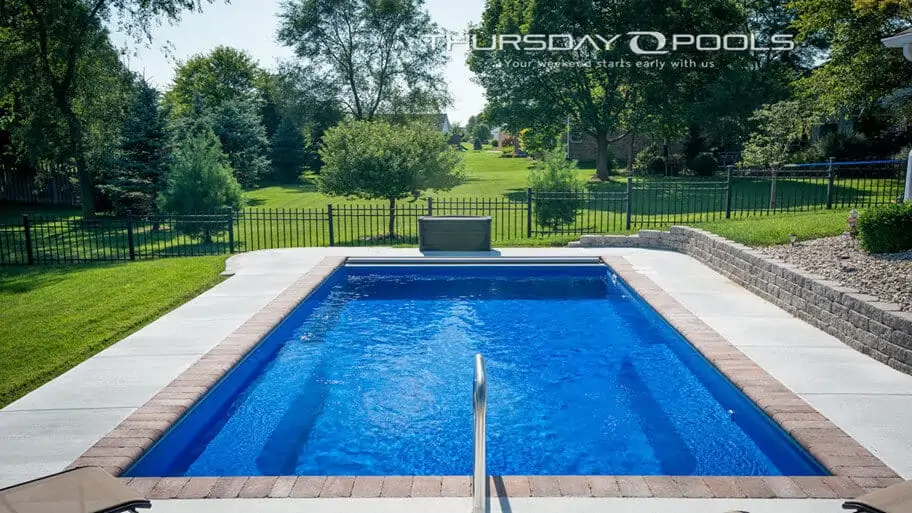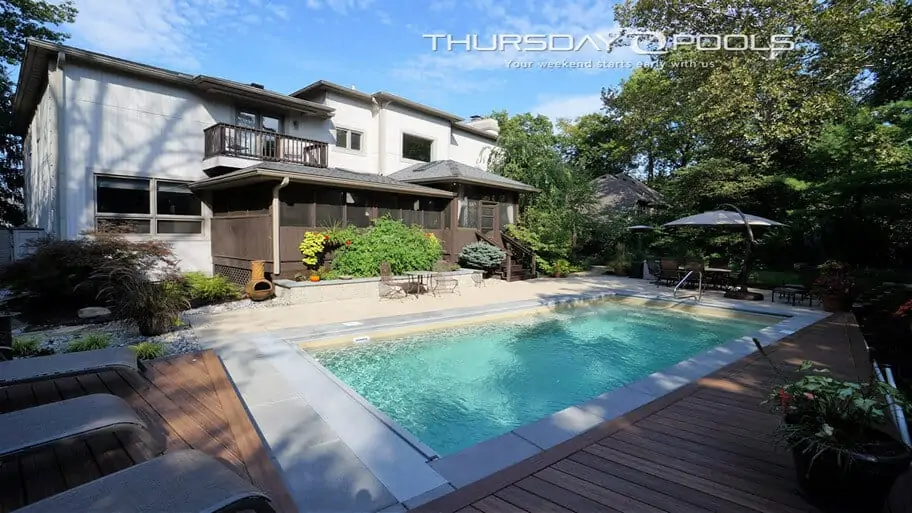Inground swimming pools are advertised as all sunshine and rainbows–as they should be because let’s be honest, swimming pools are one of the best things you can own during the summer. They provide fun for the whole family and enjoyment that can last a lifetime! However, there’s so much beneath the surface of advertising inground swimming pools. Some good and some bad, just as everything else has.
We’d love to sit here and tell you with 100% guarantee that every single detail of an inground swimming pool is all sunshine and rainbows, but we’d be doing you a disservice. Neither you, the consumer, or us, the builder, can ignore the smaller details of an inground swimming pool because in all actuality, those are what really hold the pool together–both literally and figuratively!
So, before you sign that check and hand it over to your pool builder, there’s a few things you should know that could be crucial to determining if you’re truly ready to make the investment.
We’ve had our experience with all of the finer details of inground swimming pools which we know will allow us to give you all of the information you need to make that huge decision about buying a pool. And don’t get it twisted, we don’t want to scare you at all! We just value the knowledge we’ve obtained over the years and want to pass it on to prospective consumers like you!
Maintenance Costs
You may think that the quote you’re given by a pool builder for an inground swimming pool is the collective cost, and in a sense that is true. However, a quote is what we call the “initial cost,” or the expense that you’ll have to pay at the time of installation.
The initial cost varies between pool types; take a look at the price ranges below:
- Concrete: $45,000 — $100,000
- Fiberglass: $45,000 — $75,000
- Vinyl Liner: $35,000 — $55,000
What fails to get mentioned in the same light as the initial cost of an inground swimming pool is the cost of the maintenance needed to keep the pool in good condition. Each type of pool requires maintenance, and even though requirements will vary, it’s something you won’t be able to skip over because you’ll see the consequences quickly. Below you’ll find just some of the maintenance requirements that you should expect to factor into the cost of owning an inground pool for years to come:
- Water chemistry maintenance (addition of chemicals)
- Pump/filter system cycles (added cost to electricity bill)
- Replacement liner (every 4-9 years for vinyl liner pools only)
- Resurface concrete pool every 10-15 years
- Additions to patio
- Refinishing patio
- Addition of equipment (vacuum, pool brush, heater, etc.)
- Cleaning services
Now, some of these maintenance requirements definitely won’t break the bank as they are minor purchases that do some of the fine tuning of an inground pool; however, some of the maintenance requirements can get quite expensive. Such requirements may be skimmed over during the initial purchasing process, which should not be the case because doing so can mislead you about what you’re required to do as a future pool owner. And since these requirements are so important, and sometimes pretty expensive, we’ve taken the time to dive into them in more detail in this article.
Replacement Vinyl Liner
If you’re looking to purchase a vinyl liner pool, one of the most important things you should be aware of is the eventual need for a replacement liner.
Every 4-9 years you should expect to spend between $4,000 — $5,000 on a new liner. Where you fall between those 4-9 years is dependent on a few things:
- Frequency of balancing water chemistry
- Prevention of sharp objects entering pool
- Routine cleaning
Most of all, the liner lifespan is impacted by luck. You can take great care of the entire pool, but one sharp object makes its way into the pool and BAM!, you have a tear a few feet long that requires you to purchase a whole new liner. So, all you can really do is take as good of care of a vinyl liner pool as possible and hope for the best.
Resurfacing
If you plan on purchasing a concrete pool, you’ll want to be aware that it will need to be resurfaced every 10-15 years.
Materials used for the interior’s finish such as plaster, exposed aggregate, and tile can only withstand so much for so long. Eventually, those materials will become worn down and possibly crack, creating the need for resurfacing. And since we’re in the Midwest, the rapidly-changing climate can take its toll on these materials and add to the need for resurfacing.
Typically, you should expect to spend around $10,000 each time your concrete pool needs to be refinished, which we know is a hefty chunk of change. But, since it can lack the proper emphasis, we want to make sure you’re aware of exactly what you’re getting into.
Increased Electricity Bill
An inground swimming pool requires a pump and filter system to sanitize the pool water and therefore electricity is needed to power the system during each cycle (multiple cycles may be conducted per day).
Since the system uses electricity, you should expect your electricity bill to increase once you install an inground pool. Of course, we can’t tell you how much it will increase because that is calculated by multiple contributors from the pool and your electricity provider.
Nonetheless, you should account for this when considering the purchase of an inground pool because it can have a strong impact on your monthly budget–one you may or may not be willing to take on.
Equipment Additions
The pump and filter system isn’t the only piece of equipment you’ll need to include with your inground pool. You may see the benefits in having a vacuum, pool brush, automatic safety cover, or even a pool heater if you live in an area with a cooler climate.
Equipment can be pricey depending on what you want and who it’s manufactured by. Small things like pool brushes or a handheld leaf skimmer are pretty affordable and can provide great benefits. However, once you start getting into the luxury items like vacuums and pool heaters, prices can increase drastically.
These pieces of equipment aren’t really factored into the initial cost unless your pool builder makes them available in certain packages, so it can easily get lost in the fray. And then you’re stuck searching for equipment that you can fit into your budget since you didn’t account for it at the time of purchase of your pool.
So, we want to make sure that you know pool equipment can provide great benefits to your inground pool, but it comes at a cost that you need to be prepared to factor into your overall budget.
Patio Additions/Refinishing
The last thing we’d like to place special emphasis on when preparing to purchase an inground pool doesn’t directly deal with the pool itself. Rather, it contributes to the area surrounding the pool and helps create a desired aesthetic. That’s right, we’re talking about the patio material that will surround the inground pool.
You see, there are a variety of patio materials available to install around an inground pool–each of which create their own, unique aesthetic. And each of which have their own, unique costs. Some of the materials you can choose from are:
- Standard Concrete
- Stamped Concrete
- Concrete Pavers
- Brick
- Brick Pavers
- Natural Stone
- Wood
- Travertine
- Flagstone
- Cobblestone
Regardless of which material you decide to create the patio with, it will likely have to be refinished at some point in the future. Concrete can crack, wood can become worn down and decay, weeds can grow between brick–you get the picture. So, just keep in mind that you may have to replace some materials down the road depending on what your patio consists of.
Are You Ready to Purchase an Inground Swimming Pool?
After taking in this information about some of the things that can get overlooked when purchasing an inground pool, we hope that you’ve begun to understand what truly comes along with such an investment. It’s not just a one-time thing that you get to enjoy for the next few decades. It’s time, money, and effort that you need to be comfortable and ready to devote to something that can provide a lifetime of enjoyment.
Everyone’s budget is different and therefore everyone who is serious about purchasing an inground pool will have a unique pool project. Each detail should be configured to accommodate your wants and needs not only at the time of purchase, but for each summer that you are able to reap the benefits of a pool!
If you have any further questions, check out our Learning Center where we are constantly addressing all of your swimming pool needs!





